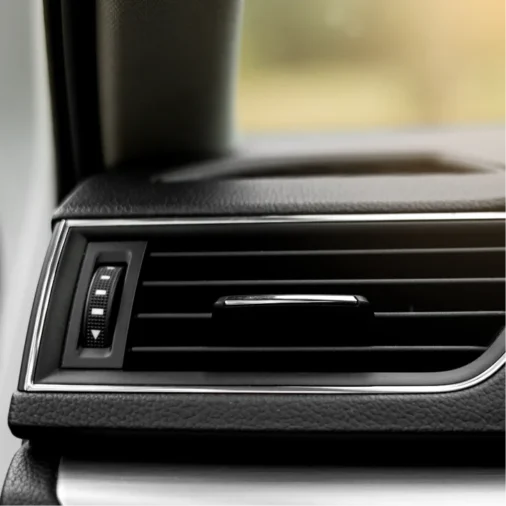Car Mold Inspection &
Testing Services In Florida

Why is a Window a Place Prone to Mold Growth?
A car is prone to mold growth due to the combination of moisture, warmth, and poor ventilation. Moisture can accumulate in a car from spills, wet clothing, humidity, or condensation, creating a damp environment. Mold thrives in warm conditions, and the interior of a car can easily heat up, especially in sunny weather. Without proper ventilation, moisture gets trapped inside, particularly in fabrics like seats and carpets, which can absorb and hold water. Leaks in windows, doors, or the sunroof can further contribute to the problem by allowing water to seep into the interior. These conditions provide the perfect breeding ground for mold, especially when organic materials like dust or food particles are present, offering a food source for mold spores.

Common signs that indicate the presence
of Car Mold are

Musty Odor
One of the most noticeable signs of mold is a persistent, musty smell inside the car, which can indicate mold or mildew growth in hidden areas like carpets or upholstery.

Visible Mold or Mildew
Mold can appear as black, green, or white spots or patches on seats, carpets, door panels, or other fabric surfaces. It may also appear on hard surfaces like the dashboard or windows if moisture has been present.

Dampness or Wetness
If the car feels damp or if you notice wet spots on the carpets or upholstery, it could be a sign that mold is forming, especially if the moisture is from a source like a spill or water leak.

Stained or Discolored Upholstery
Mold growth can cause discoloration or staining of fabric, leather, or carpeting in the car. These stains may appear as blotches or dark spots.

Allergic Reactions
If you experience sneezing, coughing, or itchy eyes while inside the car, it could be due to mold spores in the air. Mold can trigger allergic reactions in sensitive individuals.

Condensation on Windows
Excessive condensation or fogging on the windows, especially during colder weather, can indicate high humidity levels inside the car, which could promote mold growth.
Tips to Identify Car Mold
- Look closely at fabric surfaces, carpets, upholstery, door panels, and vents for dark spots, patches, or fuzzy growth.
- Mold can appear black, green, white, or even pink, depending on the type.
- A musty or earthy odor inside the car is a strong indication of mold or mildew. If the car smells damp or stale, mold may be present, even if you can't see it.
- Press on the carpets or upholstery to see if they feel damp or soggy, especially after a rainy day or if you've recently spilled something in the car.
- Moisture in these areas can lead to mold growth.
- Mold can also grow on hard surfaces like the dashboard, window seals, or interior panels.
- Check for discoloration or water stains, which may indicate mold growth in these less obvious areas.
- Check areas where leaks may occur, such as around windows, sunroofs, or door seals.
- Water pooling in these spots can lead to mold, especially if it isn’t properly cleaned up.
- Run your hand over the interior surfaces, especially under seats and mats, to feel for any dampness or moisture.
- If the interior feels consistently damp or sticky, mold may be developing.
- Mold can grow in the air conditioning system and ducts, causing spores to circulate when the AC or heater is on.
- If the air smells musty when you turn on the car’s air system, it may be a sign of mold buildup in the vents.
- Mold can leave stains or cause discoloration on carpets, upholstery, or headliners.
- Dark patches or irregular spots are a common indication of mold growth.
Regularly inspecting your Car Mold and maintaining proper ventilation, insulation,
Regular maintenance, immediate attention to spills and leaks, and ensuring proper ventilation can help prevent mold growth in carpeted areas.
ETA’s Tips for Preventing Car Mold
Here are some practical tips to help prevent mold growth in your car:

Keep the Interior Dry
- The key to preventing mold is to avoid excess moisture. After a rainy day or spill, wipe down wet surfaces immediately, and remove any wet items (like clothing, towels, or umbrellas) from the car. Use absorbent mats or towels if necessary to soak up moisture.

Use a Dehumidifier or Silica Gel Packs
- Consider placing a portable car dehumidifier or silica gel packs inside your car to absorb excess moisture. These can help keep humidity levels low, especially during rainy or humid seasons.

Regularly Air Out Your Car
- Inspect your car for any leaks in door seals, windows, or the sunroof. A small leak can allow water to enter the car, creating a damp environment that promotes mold growth. Replace faulty seals as soon as possible.

Check for Leaks
- Inspect your car for any leaks in door seals, windows, or the sunroof. A small leak can allow water to enter the car, creating a damp environment that promotes mold growth. Replace faulty seals as soon as possible.

Vacuum and Clean the Interior
- Regularly vacuum carpets, seats, and upholstery to remove dust, dirt, and food particles, which can attract mold spores. Clean spills and stains right away, and make sure all surfaces are dry after cleaning.

Use Mold-Resistant Car Upholstery Cleaner
- Clean your seats, carpets, and floor mats with a mold-resistant upholstery cleaner to help prevent mold buildup. These cleaners often have antimicrobial properties that can help protect the fabric from mold.

Maintain Proper Ventilation
- Keep the air conditioning and heating system in good condition to promote proper ventilation. After using the AC or heater, allow the system to dry out by running the fan without the cooling or heating function on for a few minutes.

Park in a Dry, Well-Ventilated Area
- Whenever possible, park your car in a dry, shaded area that is well-ventilated. Avoid parking in damp or humid places, like under trees that trap moisture or in areas prone to flooding.

Use Floor Mats
- Install rubber floor mats to protect the carpets from moisture. These are easier to clean and dry than fabric mats, which can absorb water and promote mold growth.

Inspect the Cabin Air Filter
- Check your car’s cabin air filter regularly. A clogged or dirty filter can lead to poor ventilation and trapped moisture, which can encourage mold growth in the ventilation system.
Choose ETA for Expert Mold Testing
Ensure your garage is safe and mold-free with ETA’s expert mold testing services. With our commitment to accuracy, efficiency, and customer satisfaction, you can trust us to deliver comprehensive assessments and actionable insights. Don’t wait until it’s too late—choose ETA to protect your health and property. Contact us today to schedule a professional mold inspection and take the first step towards a healthier, safer space.
Professional Mold Inspection & Air
Quality Testing Services in South Florida.

The Mold Inspection Process

DETECTION
We’ll discover the source of infrastructure damage. This is imperative and also the first step in our process.

TESTING
We send all samples to an accredited laboratory. Our labs know this is our priority and will give the most detailed results possible.

ASSESSMENT
Our certified and licensed assessors will compile a comprehensive report providing our documentation and lab analysis. All information comes with a scope of work.

Why Choose Environmental
Testing Agency?
Our team is comprised of industry-certified experts with extensive knowledge and experience in environmental testing. We utilize the latest technology and methodologies to ensure accurate and reliable results, making us leaders in the field.
Expertise
We are committed to providing exceptional customer service. Our team is responsive, thorough, and dedicated to assisting clients through every step of the testing process. We prioritize clear communication and tailored solutions to meet your specific needs.
Customer Service
Quality is at the core of everything we do. From rigorous testing procedures to detailed reporting, we ensure that all services meet the highest standards. Our commitment to quality helps clients make informed decisions based on dependable data.
Quality
Licensed, Certified,
and Insured Mold Inspection
and Air Quality Testing Company.





Before Booking an Air Quality Test
and Mold inspection Services
Receive $50 off!

Car Mold FAQs
A car mold inspection is a thorough check of your vehicle to identify mold growth and assess the level of contamination. We inspect visible mold, check for moisture buildup, and may take air or surface samples for lab testing if necessary.
Mold thrives in damp, humid environments. Common causes include water leaks, wet seats or carpets, poor ventilation, and high humidity levels. If moisture isn’t removed quickly, mold can spread and cause unpleasant odors and potential health risks.
Yes, mold in a car can trigger allergies, respiratory issues, headaches, and skin irritation, especially for those with asthma or weakened immune systems. Prolonged exposure can also damage the interior of your vehicle.
We use specialized cleaning solutions and professional-grade equipment to remove mold safely and effectively. This includes deep cleaning surfaces, eliminating moisture sources, and applying antimicrobial treatments to prevent regrowth
While DIY methods like vinegar or baking soda may remove surface mold, they don’t always eliminate the root cause. Professional removal ensures all mold spores are eliminated, preventing recurrence and protecting your health.
To prevent mold, keep your car dry by fixing leaks, using moisture absorbers, airing out the interior, and cleaning spills immediately. Parking in a dry, well-ventilated area also helps reduce humidity buildup.
Yes, professional mold removal eliminates the mold spores responsible for the odor. We also use odor-neutralizing treatments to ensure your car smells fresh and clean.
The process can take a few hours to a full day, depending on the severity of the mold issue. We’ll provide a time estimate after inspecting your vehicle.
If moisture issues aren’t addressed, mold can return. That’s why we not only remove mold but also help identify and fix the underlying cause to prevent future growth.
If you notice a musty smell, see visible mold, or experience allergy-like symptoms inside your car, it’s best to schedule an inspection as soon as possible. Early detection can prevent further damage and health risks.
Areas We Serve
In Florida
1. Miami Dade
- Coral Gables
- Coconut Grove
- Miami Beach
- Star, Palm & Hibiscus Island
- Key Biscayne
- Keystone Islands
- San Souci
- Miami Shores
- Pinecrest
- Brickel
- Bal Harbor
- Bay Harbor Islands
- Indian Creek
- Surfside
- Eastern Shores
- Sunny Isles
- Aventura
- Golden Isles
- Golden Beach
- The Roads
2. Broward
3.Palm Beach
- Royal Palm Beach
- Lake Worth
- Lantana
- Boca Raton
- Boynton Beach
- Manalapan
- Singer Island
- South Palm Beach
- North Palm Beach
- Tequesta
- Highland Beach
- Ocean Ridge
- Country Club Acres
1. Miami Dade
- Coral Gables
- Coconut Grove
- Miami Beach
- Star, Palm & Hibiscus Island
- Key Biscayne
- Keystone Islands
- San Souci
- Miami Shores
- Pinecrest
- Brickel
- Bal Harbor
- Bay Harbor Islands
- Indian Creek
- Surfside
- Eastern Shores
- Sunny Isles
- Aventura
- Golden Isles
- Golden Beach
- The Roads
2. Broward
- Bonaventure
- Hallandale
- Miramar
- Hillsboro Beach
- North Lauderdale
- Coconut Creek
- Hollywood
- Sea Ranch Lakes
- Oakland Park
- Sunrise
- Coral Springs
- Parkland
- Dania
- Lauderdale By The Sea
- Pembroke Park
- Tamarac
- Davie
- Pembroke Pines
- University Park
- Deerfield Beach
- Plantation
- Weston
- Fort Lauderdale
- Lighthouse Point
- Pompano Beach
- Wilton Manors
3. Palm Beach
- Royal Palm Beach
- Lake Worth
- Lantana
- Boca Raton
- Boynton Beach
- Manalapan
- Singer Island
- South Palm Beach
- North Palm Beach
- Tequesta
- Highland Beach
- Ocean Ridge
- Country Club Acres
- Jupiter
- Palm Beach
- Jupiter Inlet Colony
- Palm Beach Gardens
- Wellington
- Jupiter Island
- Palm Beach Shores
- Delray Beach
- Palm Springs
- Lake Clarke Shores
- Pelican Lake
- West Palm Beach




